On Numerical Simulations of Turbulent Flows over a Bluff Body with Aerodynamic Flow Control Based on Trapped Vortex Cells: Viscous Effects
Abstract
1. Introduction
- To perform numerical simulations based on LES on a simplified bluff body with AFC at Re = 130,000 and zero angle of attack. To investigate its aerodynamic characteristics and energy losses and to verify that the flow is practically unseparated, except for small-scale turbulence.
- Based on the classical RANS approach, to numerically investigate the effect of viscosity on the design efficiency and to show that this concept is practically invariant with respect to the Reynolds number, i.e., the lift-to-drag ratio is approximately constant over a wide range of Reynolds numbers (50,000 ≤ Re ≤ 1,000,000) and converges to an asymptotic value. The limiting case when the Reynolds number tends to infinity, , is estimated based on both analytical considerations and a numerical experiment in which the Euler equations are solved. As a general result, it was found that the lift force of the developed concept is approximately of its limiting analytical value ().
2. Problem Statement and Theoretical Considerations
2.1. Overview of the Aerodynamic Flow Control Concept Based on the Trapped Vortex Cells
2.2. Overview of the Large Eddy Simulation Technique
2.3. Ultimate Analytical Lift Properties of Airfoils in Potential Flows
- —flow around a flat-plate airfoil installed at a given angle of attack (see Figure 3a): . The max theoretical value of the lift force of a thin plate is achieved at the angle of attack, ,
- —flow around a curved plate in the form of a half-circle (see Figure 3b). In this case, the following values of can be obtained:One can see clearly that the maximum lift coefficient can be achieved for . Of course, the value of depends on the length used as a reference. Here, it is assumed that the conventional chord is applied. For a circle, under the imposed assumptions, it is possible to recover as a limit. In the same spirit, the half-circle limit of can be considered. That is the limiting value for any single-element airfoil [30].
3. Brief Aspects of the Numerical Simulations
3.1. Overview of the Numerical Methodology
3.2. Computational Grids
3.3. Boundary and Initial Conditions
4. Results
4.1. LES Results
4.2. Analysis of the Viscous Effects Based on the RANS Approach
- The results obtained in 2D deviate by approximately 7% from the 3D results for Reynolds numbers of 75,000 and 130,000. As the Reynolds number increases, this discrepancy diminishes.
- There is almost perfect agreement between the baseline simulations using the realizable k- turbulence model on the A0 and A1 grids, indicating grid independence.
- The influence of turbulence models is limited; both RKE and SA models show the same trend but have a systematic shift of around .
- For the limiting case of inviscid fluid, the lift coefficient value is about 5% lower than the values obtained using RKE for a Reynolds number of 1,000,000. This is explained by vortex breakups or the coexistence of small coherent vortex structures in the trapped vortex cells and additional vortices in the system channels, as demonstrated in Figure 8d. The limiting case confirms the general trend.
- From the perspective of numerical modeling, satisfactory agreement is achieved between the aerodynamic coefficients, with a minimum difference of 5% for LES and RANS for a Reynolds number of 130,000. It is important to emphasize that for both approaches, grid dependence of the solution is practically non-existent. The agreement between the results can be attributed to the consistency of both methodologies and the use of a differential, algebraic equation for the kinetic energy to close the Navier–Stokes equations.
5. Discussion
5.1. Critical Remark on the Grid Independence Study
5.2. Comparison of Results Obtained by the LES and RANS Approaches
5.3. Effects of Compressibility
6. Conclusions
Funding
Institutional Review Board Statement
Informed Consent Statement
Data Availability Statement
Conflicts of Interest
Abbreviations
| AF | Ansys Fluent |
| AFC | Aerodynamic Flow Control |
| AMG | Algebraic Multigrid Method |
| BB | Bluff Body |
| BDF | Backward Differencing Formula |
| CC | Circular Cylinder |
| CDS | Central Differencing Scheme |
| CFD | Computational Fluid Dynamics |
| CRANE | Control of Revolutionary Aircraft with Novel Effectors |
| FVM | Finite Volume Method |
| GAMG | Geometric Multigrid Method |
| HC | Semi-Circular Cylinder |
| LES | Large Eddy Simulation |
| LIC | Line Integral Convolution |
| Probability Density Distribution | |
| RANS | Reynolds-Averaged Navier–Stokes |
| SOU | Second-Order Upwind Scheme |
| TVC | Trapped Vortex Cell |
References
- Joshi, S.N.; Gujarathi, Y.S. A review on active and passive flow control techniques. Int. J. Recent Technol. Mech. Electr. Eng. 2016, 3, 1–6. [Google Scholar]
- Greenblatt, D.; Williams, D.R. Flow control for Unmanned Air Vehicles. Annu. Rev. Fluid Mech. 2022, 54, 383–412. [Google Scholar] [CrossRef]
- Lee, S.; Zhao, Y.; Luo, J.; Zou, J.; Zhang, J.; Zheng, Y.; Zhang, Y. A Review of Flow Control Strategies for Supersonic/Hypersonic Fluid Dynamics. Aerosp. Res. Commun. 2024, 2, 13149. [Google Scholar] [CrossRef]
- Bharghava, D.S.N.; Jana, T.; Kaushik, M. A survey on synthetic jets as active flow control. Aerosp. Syst. 2024, 7, 435–451. [Google Scholar] [CrossRef]
- Mariaprakasam, R.D.R.; Mat, S.; Samin, P.M.; Othman, N.; Wahid, M.; Said, M. Review on flow controls for vehicles aerodynamic drag reduction. J. Adv. Res. Fluid Mech. Therm. Sci. 2023, 101, 11–36. [Google Scholar] [CrossRef]
- Rashidi, S.; Hayatdavoodi, M.; Esfahani, J.A. Vortex shedding suppression and wake control: A review. Ocean Eng. 2016, 126, 57–80. [Google Scholar] [CrossRef]
- Chen, W.-L.; Huang, Y.; Chen, C.; Yu, H.; Gao, D. Review of active control of circular cylinder flow. Ocean Eng. 2022, 258, 111840. [Google Scholar] [CrossRef]
- Derakhshandeh, J.F.; Alam, M.M. A review of bluff body wakes. Ocean Eng. 2019, 182, 475–488. [Google Scholar] [CrossRef]
- Lekkala, M.R.; Latheef, M.; Jung, J.H.; Coraddu, A.; Zhu, H.; Srinil, N.; Lee, B.-H.; Kim, D.K. Recent advances in understanding the flow over bluff bodies with different geometries at moderate Reynolds numbers. Ocean Eng. 2022, 261, 111611. [Google Scholar] [CrossRef]
- Tayebi, A.; Torabi, F. Flow control techniques to improve the aerodynamic performance of Darrieus vertical axis wind turbines: A critical review. J. Wind. Eng. Ind. Aerodyn. 2024, 252, 105820. [Google Scholar] [CrossRef]
- Airforce Technology. X-65 CRANE Demonstrator Aircraft, US. Available online: https://www.airforce-technology.com/projects/x-65-crane-demonstrator-aircraft-us/ (accessed on 20 January 2024).
- Sedda, S.; Sardu, C.; Lasagna, D.; Iuso, G.; Donelli, R.S.; Gregorio, F.D. Trapped vortex cell for aeronautical applications: Flow analysis through PIV and Wavelet transform tools. In Proceedings of the 10th Pacific Symposium on Flow Visualization and Image Processing, Naples, Italy, 15–18 June 2015. [Google Scholar]
- Lysenko, D.A.; Donskov, M.; Ertesvåg, I.S. Large-eddy simulations of the flow past a bluff-body with active flow control based on trapped vortex cells at Re = 50,000. Ocean Eng. 2023, 280, 114496. [Google Scholar] [CrossRef]
- Ringleb, F.O. Separation control by trapped vortices. In Boundary Layer and Flow Control; Lachmann, G.V., Ed.; Pergamon Press: Elmsford, NY, USA, 1961. [Google Scholar]
- Kasper, W. Aircraft Wing with Vortex Generation. U.S. Patent 3,831,885, 27 August 1974. [Google Scholar]
- Kruppa, E.W. A Wind Tunnel Investigation of the Kasper Vortex Concept. In AIAA Paper; American Institute of Aeronautics and Astronautics: Reston, VA, USA, 1977; pp. 77–310. [Google Scholar]
- Savitsky, A.I.; Schukin, L.N.; Karelin, V.G.; Mass, A.M.; Pushkin, R.M.; Shibamov, A.P.; Schukin, I.L.; Fischenko, S.V. Method for Controlling Boundary Layer on an Aerodynamic Surface of a Flying Vehicle. U.S. Patent 5,417,391, 23 May 1995. [Google Scholar]
- Ermishin, A.V.; Isaev, S.A. Flow Control Past Bodies with Vortex Cells Applied to a Blended Wing-Body Aircraft (Numerical and Physical Modeling); St. Petersburg University of Civil Aviation: Saint-Petersburg, Russia, 2024. (In Russian) [Google Scholar]
- Donelli, R.; Gregorio, F.D.; Iannelli, P. Flow separation control by trapped vortex. In Proceedings of the 48th AIAA Aerospace Sciences Meeting Including the New Horizons Forum and Aerospace Exposition, Orlando, FL, USA, 4–7 January 2010; p. 1409. [Google Scholar]
- Isaev, S.A. Aerodynamics of Thickened Bodies with Vortex Cells (Numerical and Physical Modeling); St. Petersburg Polytechnic University: Saint-Petersburg, Russia, 2016. (In Russian) [Google Scholar]
- Lysenko, D.A.; Ertesvåg, I.S. Assessment of algebraic subgrid scale models for the flow over a triangular cylinder at Re = 45,000. Ocean Eng. 2021, 222, 108559. [Google Scholar] [CrossRef]
- Lysenko, D.A.; Donskov, M.; Ertesvåg, I.S. Large-eddy simulations of the flow over a semi-circular cylinder at Re = 50,000. Comput. Fluids 2021, 228, 10505. [Google Scholar] [CrossRef]
- Lysenko, D.A. Large-eddy simulation of the flow past a circular cylinder at Re = 130,000: Effects of numerical platforms and single- and double-precision arithmetic. Fluids 2025, 10, 4. [Google Scholar] [CrossRef]
- Geurts, B. Elements of Direct and Large-Eddy Simulation; R.T.Edwards: Philadelphia, PA, USA, 2004. [Google Scholar]
- Garnier, E.; Adams, N.; Sagaut, P. Large Eddy Simulation for Compressible Flows; Springer: New York, NY, USA, 2009. [Google Scholar]
- Schumann, U. Subgrid scale model for finite difference simulations of turbulent flows in plane channels and annuli. J. Comput. Phys. 1975, 18, 376–404. [Google Scholar] [CrossRef]
- Horiuti, K. Large eddy simulation of turbulent channel flow by one-equation modeling. J. Phys. Soc. Jpn. 1985, 54, 2855–2865. [Google Scholar] [CrossRef]
- Yoshizawa, A. Statistical theory for compressible shear flows, with the application to subgrid modelling. Phys. Fluids 1986, 29, 1416–1429. [Google Scholar] [CrossRef]
- Sagaut, P. Large Eddy Simulation for Incompressible Flows, 3rd ed.; Springer: Berlin, Germany, 2006. [Google Scholar]
- Smith, A.M.P. High lift aerodynamics. In AIAA Paper No. 74939; 1974; Available online: https://charles-oneill.com/aem614/ReferenceMaterial/A+M+O+Smith+HIGH+LIFT+AERODYNAMICS.pdf (accessed on 5 March 2025).
- ANSYS FLUENT 2021SRb. Theory guide. In Tech. Rep.; Ansys Inc.: Canonsburg, PA, USA, 2021.
- Issa, R. Solution of the implicitly discretized fluid flow equations by operator splitting. J. Comput. Phys. 1986, 62, 40–65. [Google Scholar] [CrossRef]
- Hutchinson, B.; Raithby, G. A multigrid method based on the additive correction strategy. J. Numer. Heat Transfer. 1986, 9, 511–537. [Google Scholar]
- Shih, T.H.; Liou, W.; Shabbir, A.; Yang, Z.; Zhu, J. A new k eddy-viscosity model for high Reynolds number turbulent flows—Model development and validation. J. Comput. Fluids 1995, 24, 227–238. [Google Scholar] [CrossRef]
- Lysenko, D.A.; Ertesvåg, I.S.; Rian, K.E. Modeling of turbulent separated flows using OpenFOAM. Comput. Fluids 2013, 80, 408–422. [Google Scholar] [CrossRef]
- Godunov, S.K.; Bohachevsky, I. Finite difference method for numerical computation of discontinuous solutions of the equations of fluid dynamics. Mat. Sb. 1959, 47, 271–306. [Google Scholar]
- Liou, M.-S.; Steffen, C. A new flux splitting scheme. J. Comput. Phys. 1993, 107, 23–39. [Google Scholar] [CrossRef]
- Kader, B. Temperature and concentration profiles in fully turbulent boundary layers. Int. J. Heat Mass Transf. 1981, 24, 1541–1544. [Google Scholar] [CrossRef]
- Wolfshtein, M. The velocity and temperature distribution of one-dimension flow with turbulence augmentation and pressure gradient. Int. J. Heat Mass Transf. 1969, 12, 301–318. [Google Scholar] [CrossRef]
- Chen, H.C.; Patel, V.C. Near-wall turbulence models for complex flows including separation. AIAA J. 1988, 26, 641–648. [Google Scholar] [CrossRef]
- Jongen, T. Simulation and Modeling of Turbulent Incompressible Flows. Ph.D. Thesis, EPF Lausanne, Lausanne, Switzerland, 1992. [Google Scholar]
- Shur, M.L.; Spalart, P.R.; Strelets, M.K.; Travin, A.K. Synthetic turbulence generators for RANS-LES interfaces in zonal simulations of aerodynamic and aeroacoustic problems. Flow Turbul. Combust. 2014, 93, 63–92. [Google Scholar] [CrossRef]
- Lysenko, D.A. Free stream turbulence intensity effects on the flow over a circular cylinder at Re = 3900: Bifurcation, attractors and Lyapunov metric. Ocean Eng. 2023, 287, 115787. [Google Scholar] [CrossRef]
- Cantwell, B.; Coles, D. An experimental study of entrainment and transport in the turbulent near wake of a circular cylinder. J. Fluid Mech. 1983, 136, 321–374. [Google Scholar] [CrossRef]
- Lim, H.-C.; Lee, S.-J. Flow control of circular cylinders with longitudinal grooved surfaces. AIAA J. 2002, 40, 2027–2036. [Google Scholar] [CrossRef]
- Spalart, P.; Allmaras, S. A one-equation turbulence model for aerodynamic flows. In Technical Report AIAA-92-0439; 1992. Available online: https://turbmodels.larc.nasa.gov/Papers/RechAerosp_1994_SpalartAllmaras.pdf (accessed on 5 May 2025).
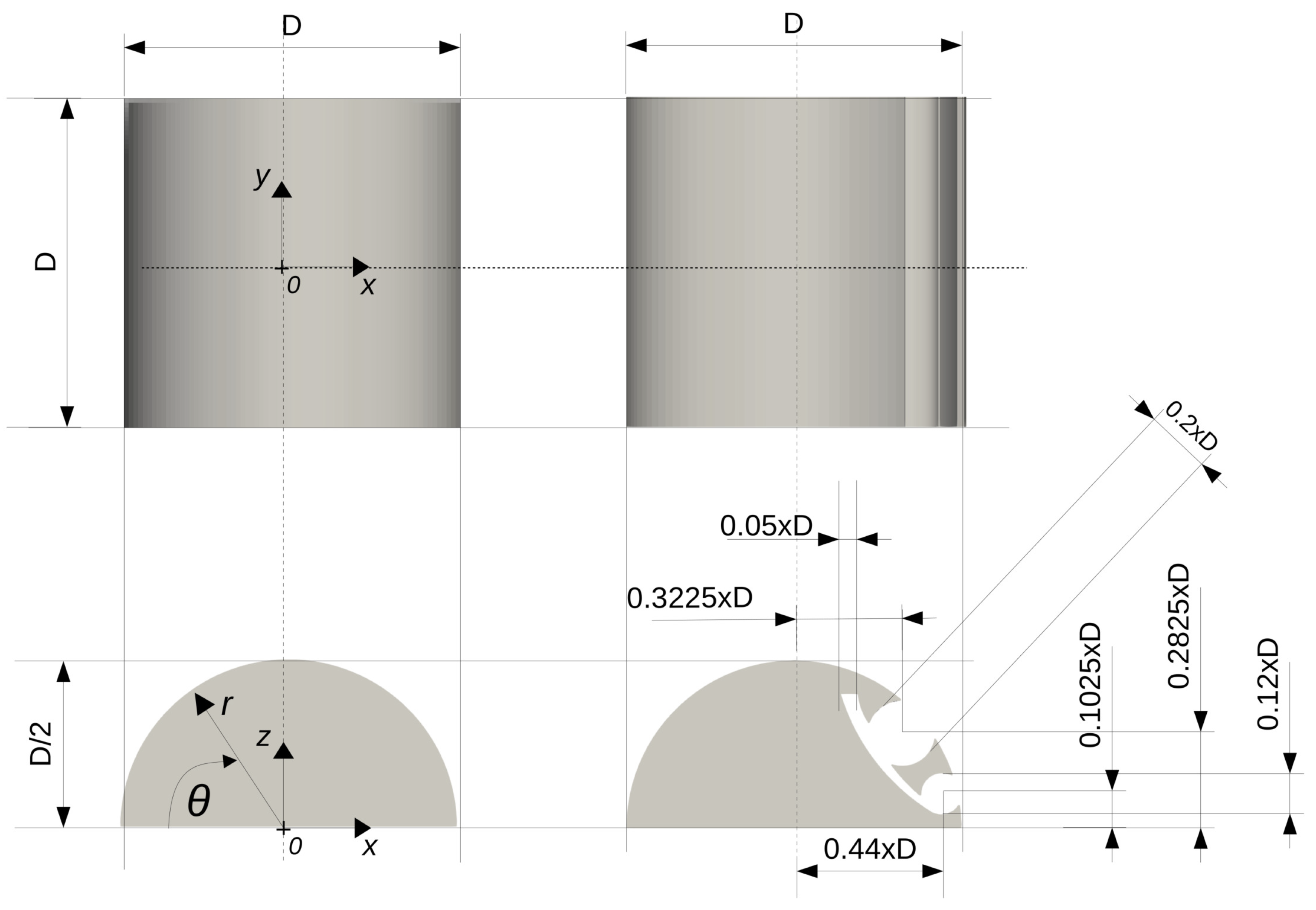









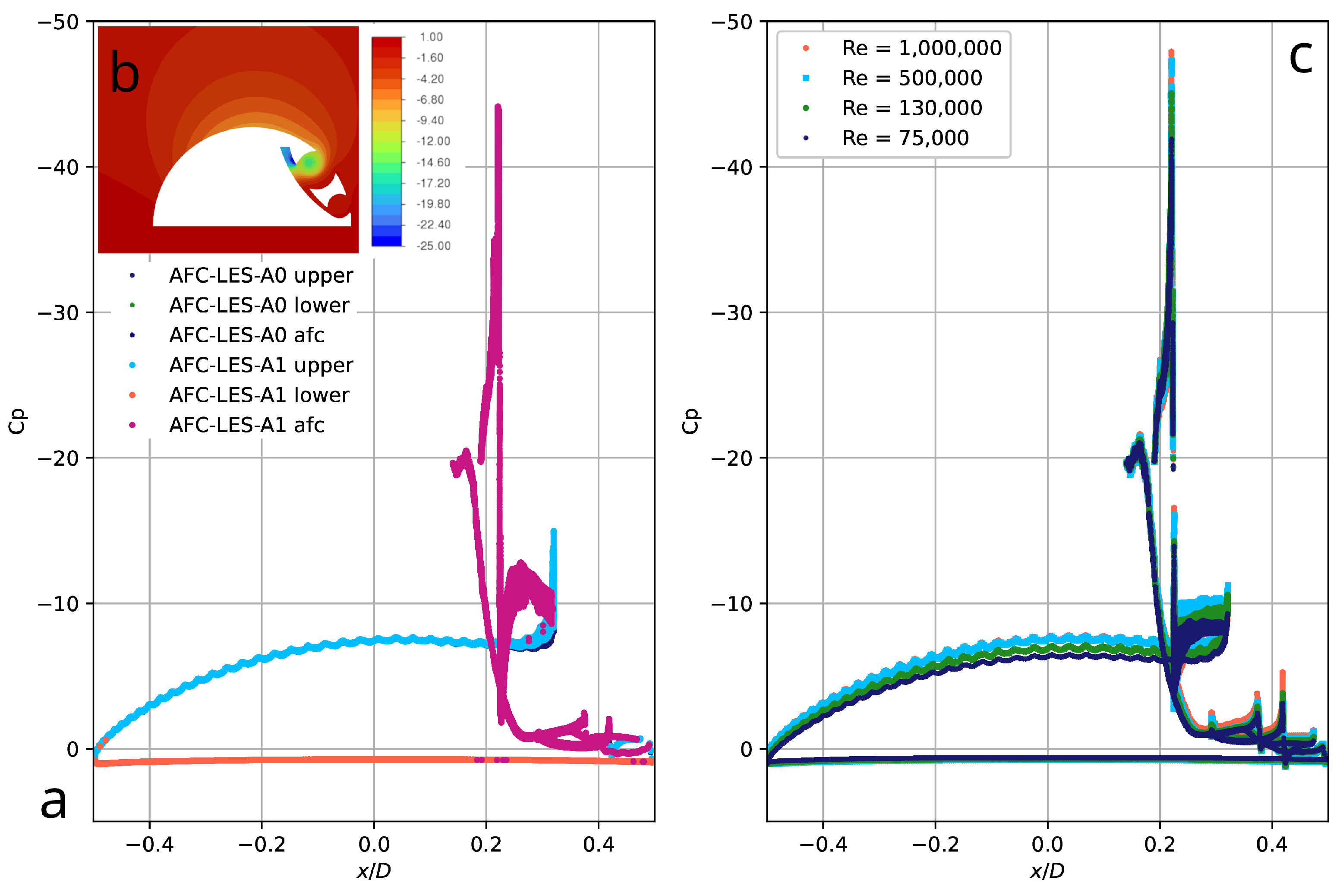
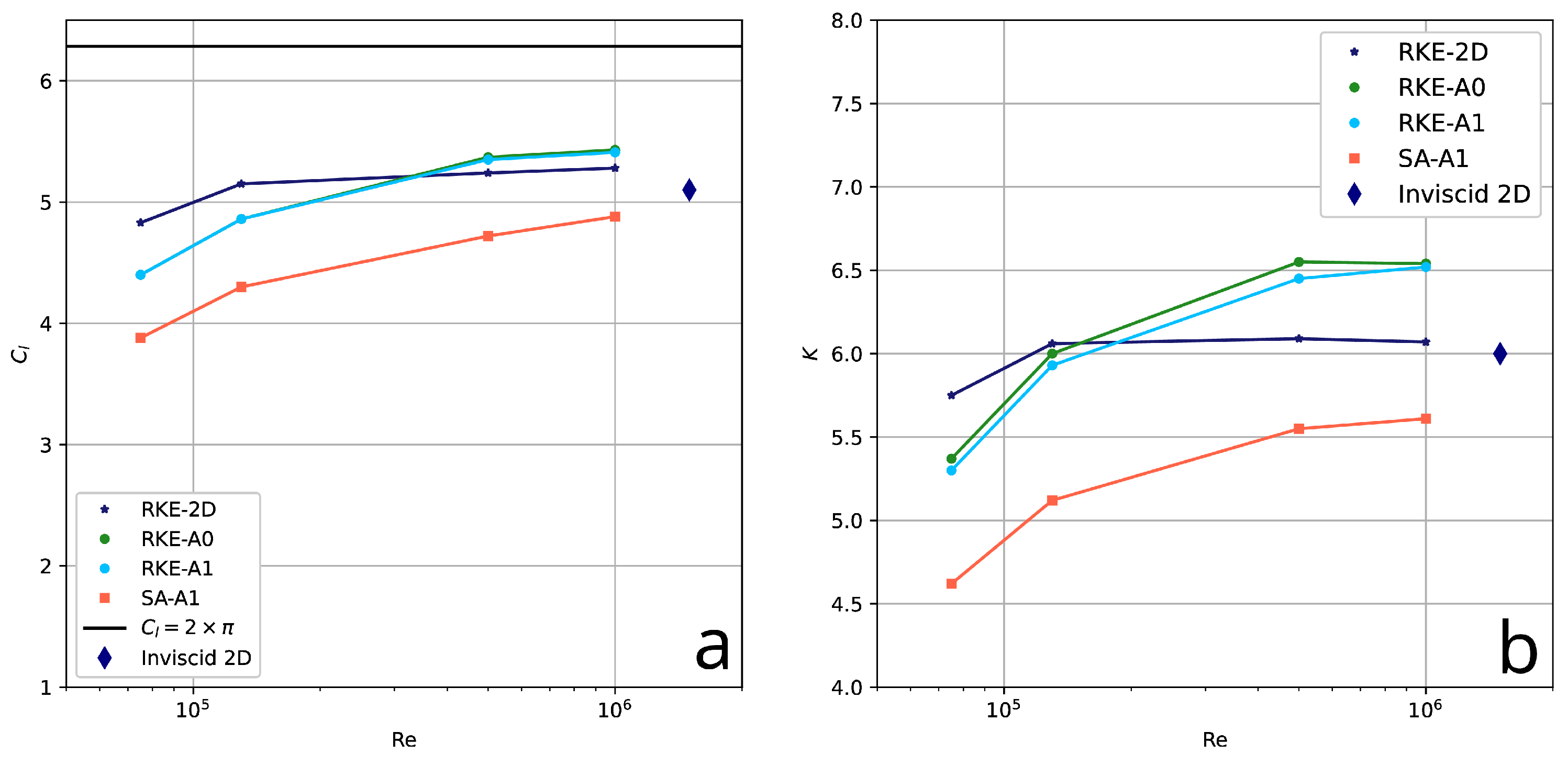
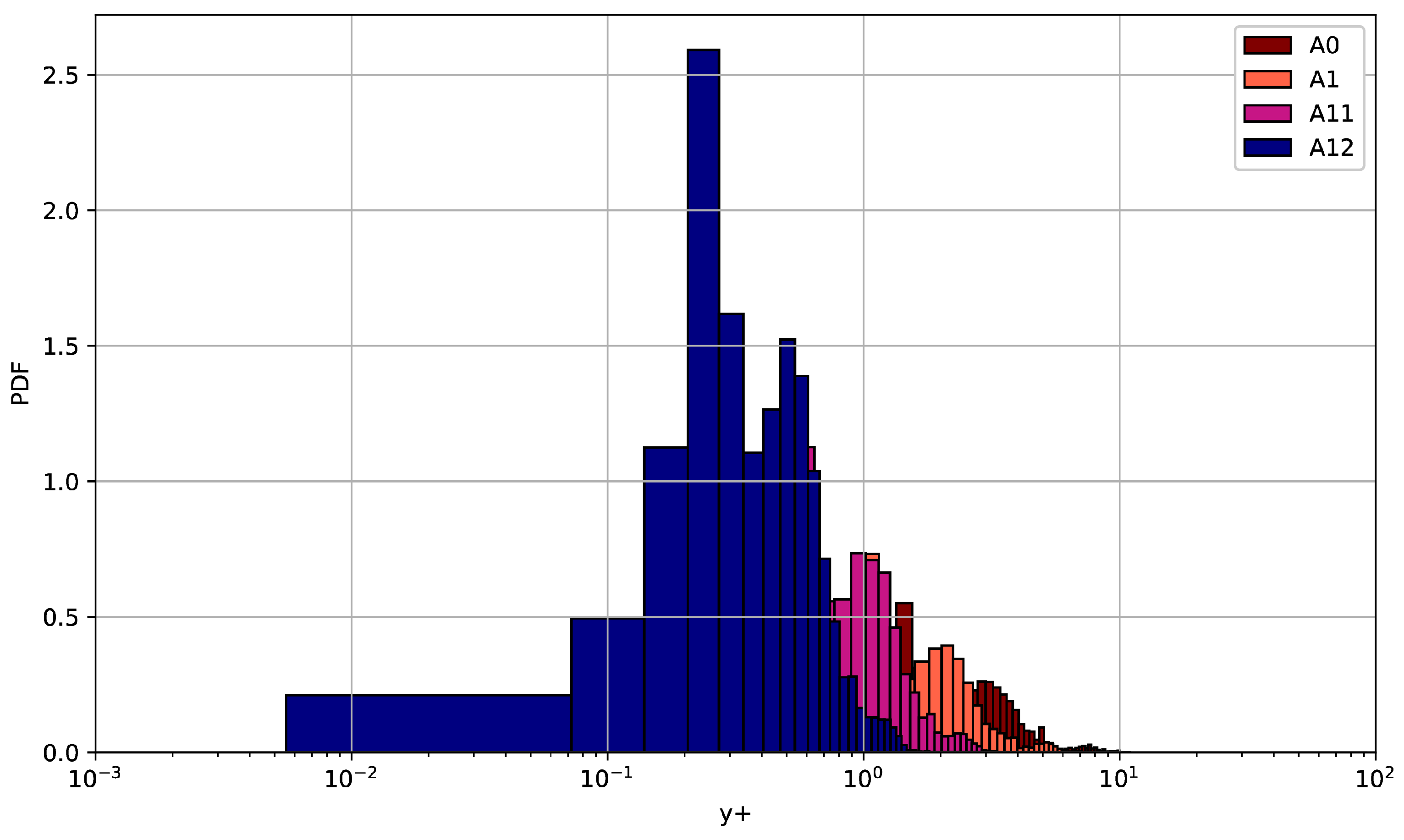


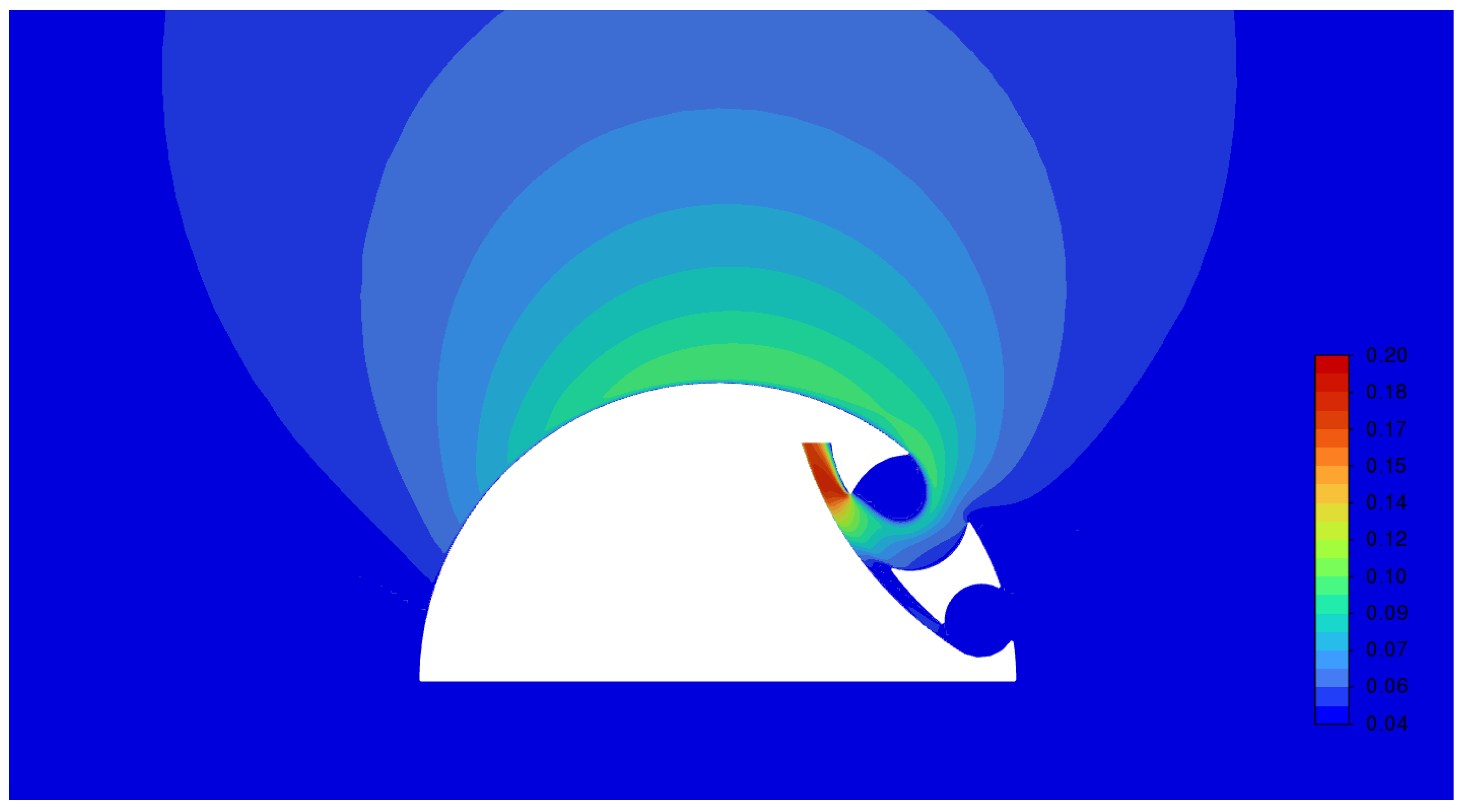
| Run | Re/1000 | |||
|---|---|---|---|---|
| LES-AFC-A0 | 0.870 | 5.094 | 5.855 | 130 |
| LES-AFC-A1 | 0.875 | 5.092 | 5.819 | 130 |
| LES-HC-H0 | 0.387 | −0.883 | −2.152 | 130 |
| Previous results | ||||
| LES-AFC02 [13] | 0.525 | 0.760 | 1.448 | 50 |
| LES-HC2-dTKE [21] | 0.469 | −1.035 | −2.207 | 50 |
| TM | Mesh | Re/1000 | Case ID | |||
|---|---|---|---|---|---|---|
| SA | A1 | 0.84 | 3.88 | 4.62 | 75 | |
| SA | A1 | 0.84 | 4.3 | 5.12 | 130 | |
| SA | A1 | 0.85 | 4.72 | 5.55 | 500 | |
| SA | A1 | 0.87 | 4.88 | 5.61 | 1000 | |
| RKE | A0 | 0.82 | 4.4 | 5.37 | 75 | |
| RKE | A0 | 0.81 | 4.86 | 6.00 | 130 | AFC-RANS-A0 |
| RKE | A0 | 0.82 | 5.37 | 6.55 | 500 | |
| RKE | A0 | 0.83 | 5.43 | 6.54 | 1000 | |
| RKE | A1 | 0.83 | 4.4 | 5.30 | 75 | |
| RKE | A1 | 0.82 | 4.86 | 5.93 | 130 | AFC-RANS-A1 |
| RKE | A1 | 0.83 | 5.35 | 6.45 | 500 | |
| RKE | A1 | 0.83 | 5.41 | 6.52 | 1000 | |
| RKE | 2D | 0.84 | 4.83 | 5.75 | 75 | |
| RKE | 2D | 0.85 | 5.15 | 6.06 | 130 | |
| RKE | 2D | 0.86 | 5.24 | 6.09 | 500 | |
| RKE | 2D | 0.87 | 5.28 | 6.07 | 1000 | |
| Inviscid | 2D | 0.85 | 5.1 | 6.00 | ∞ | |
| Incompressible RKE | A0 | 0.82 | 4.82 | 5.88 | 130 |
| Mesh | ||
|---|---|---|
| A0 | 0.81 | 4.86 |
| A1 | 0.82 | 4.86 |
| A11 | 0.83 | 4.83 |
| A12 | 0.83 | 4.83 |
Disclaimer/Publisher’s Note: The statements, opinions and data contained in all publications are solely those of the individual author(s) and contributor(s) and not of MDPI and/or the editor(s). MDPI and/or the editor(s) disclaim responsibility for any injury to people or property resulting from any ideas, methods, instructions or products referred to in the content. |
© 2025 by the author. Licensee MDPI, Basel, Switzerland. This article is an open access article distributed under the terms and conditions of the Creative Commons Attribution (CC BY) license (https://creativecommons.org/licenses/by/4.0/).
Share and Cite
Lysenko, D.A. On Numerical Simulations of Turbulent Flows over a Bluff Body with Aerodynamic Flow Control Based on Trapped Vortex Cells: Viscous Effects. Fluids 2025, 10, 120. https://doi.org/10.3390/fluids10050120
Lysenko DA. On Numerical Simulations of Turbulent Flows over a Bluff Body with Aerodynamic Flow Control Based on Trapped Vortex Cells: Viscous Effects. Fluids. 2025; 10(5):120. https://doi.org/10.3390/fluids10050120
Chicago/Turabian StyleLysenko, Dmitry A. 2025. "On Numerical Simulations of Turbulent Flows over a Bluff Body with Aerodynamic Flow Control Based on Trapped Vortex Cells: Viscous Effects" Fluids 10, no. 5: 120. https://doi.org/10.3390/fluids10050120
APA StyleLysenko, D. A. (2025). On Numerical Simulations of Turbulent Flows over a Bluff Body with Aerodynamic Flow Control Based on Trapped Vortex Cells: Viscous Effects. Fluids, 10(5), 120. https://doi.org/10.3390/fluids10050120









